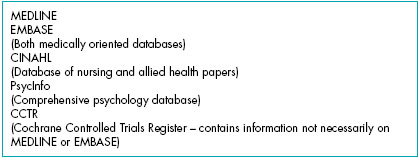The amount of information which will be gathered is affected by the focus of the review, but also by the breadth of sources of information searched. Searches usually begin with a scrutiny of electronic databases (see Figure 4.3). However, for a comprehensive review, such a search is rarely enough. Lesser-known journals may not be on the databases, whilst publication bias may result in only certain types of study being reported. Perhaps the most well known (and potentially important) form of publication bias is the tendency of journals to publish only studies with significant findings, and only original studies (as opposed to replication studies). This tendency is an important source of bias because negative findings are of value, whilst replication studies (particularly failures to replicate findings) are an important check in quantitative research, which is probabilistic in nature. Well-conducted replication studies which do not support the findings of an original study cast doubt on the original findings because they suggest that these originally significant finding may have been the result of a type I error (see Chapter 20). In order to find such studies, we need to go beyond the results of electronic searches. Typically, this involves hunting down references cited in studies found in electronic searches, including unpublished work, or work which has been published outside the academic arena (so-called ‘grey literature’ such as internal reports, working papers, theses, newspaper articles). It is also important to search for conference proceedings, where new and emerging work may first be presented. For such new work, research registers such as the national Research Register (https://portal.nihr.ac.uk/Pages/NRRArchive. aspx) is an excellent source, and a comprehensive review will examine this register and similar ones and follow up potentially relevant work in progress by contacting the researchers. In the case of reviews of the effectiveness of drugs and medical appliances and devices, a comprehensive review should involve contacting manufacturers, who have often undertaken research which never finds its way into the academic journals. They may be willing to share their findings with reviewers. Finally, the internet is a vast source of unregulated publication, much of it of dubious quality. It is, nevertheless, a potentially relevant source, at least as a first step in unearthing grey literature and contacting people researching in the same area. Patients and carers can make an important contribution to literature reviews, as they may have considerable experience of searching for materials which relate to their health issues. This expertise can be especially useful in addressing the grey literature.
Stay updated, free articles. Join our Telegram channel

Full access? Get Clinical Tree




